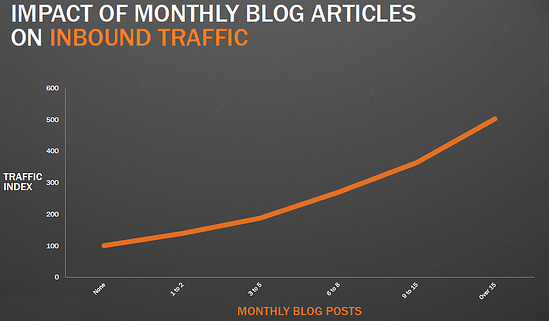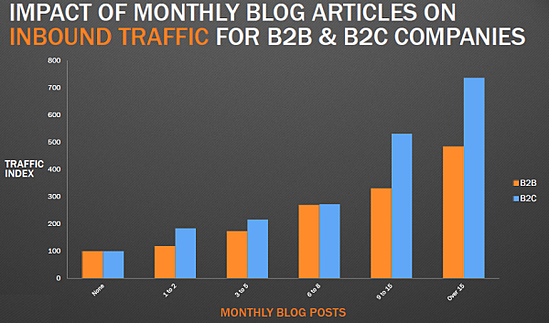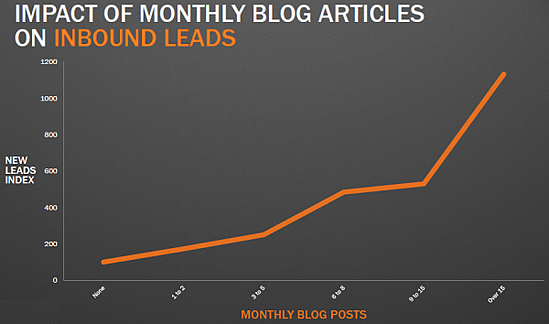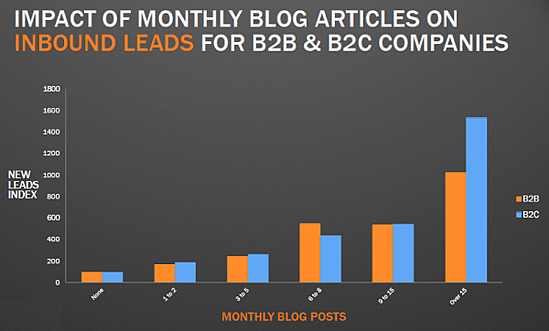“Is there an ideal blog publishing frequency?” is a question I often hear from our prospects and customers. It’s no wonder. For many larger companies, scheduling blog posts is a guessing game at best.
Unfortunately, even some content teams for large, established brands don’t really have a coherent blogging strategy in place. As a result, their content calendar looks like a random patchwork quilt.
Do all audience segments want to read posts at the same frequency? If not, how do we know how often to post for each segment?
A Question of Timing
Today’s marketers have a lot going on. On any given day, we’re buried in meetings and email and, if we have time left in the day, we’re creating and managing content and engaging our audiences on multiple channels. And then your boss walks in…”Hey, we’re about ready to launch a new widget, so we’re going to need an all-new content effort to promote it.”
For some, the daily grind of to-dos simply gets in the way of our ability to create and publish content on a consistent basis. Others don’t stand a chance since they haven’t defined any sort of publishing frequency or schedule in the first place.
Since studies show that more than 60 percent of customer purchases begin with a Google search, your content planning teams should first discover what your target customers are searching for – and how frequently they search.
So, any answers about the perfect posting frequency will depend on your target audience’s questions, pain points, curiosity, and other factors that drive their searches.
Quality vs. Quantity
The road to consistency begins with an identification of a publishing frequency that you can sustain. But nailing that down will only get you out of the driveway. You also need to set expectations on the quality of the content, as high-quality content typically takes longer to produce and thus may require a lower frequency.
Statistically, blogging two to four times a week is a good rule of thumb to aim for. According to research by Marketing Insider Group, posting frequency yields more traffic and conversions for both B2C and B2B companies.
But there’s a caveat. Those studies assume that you have a well-organized, customer-focused, and data-driven content strategy. And, those numbers don’t tell you which segments should get more posts and which only need two per week. So that brings us back to the eternal content publishing dilemma.
The content quality vs. quantity debate has been going on for over a decade now in content marketing circles. If you’re really interested in seeing which side is winning these days, just Google it and we bid you a “good luck.” We certainly have our own opinions on this topic, but there are some harsh realities that you should consider when thinking about the publishing frequency of any new content initiative.
Done right, content marketing starts with the customer. As content strategist Kristina Halvorson put it, “The heart of any good content strategy is putting your audience or putting your users at the center of everything you do.”
Start with a Deep Dive into Your Analytics
Start by sketching out buyer personas. Use your social media and content analytics to discover your audience’s demographics, pain points, needs, location, preferred channels, time online, and other characteristics.
Create a “portrait” of these target customer segments. Some content teams like to give these buyer personas descriptive names, like “Busy Builder Bob” or “Techie Tina,” to create a snapshot of their needs.
Then, start asking questions. Use your social media platforms to reach out and learn what kinds of information they need to solve their problems or satisfy their curiosity.
Ask them how often they read your posts – and if there are any topics that you’re giving short shrift to. Are you posting so frequently that they roll their eyes when they see yet another blog post about your pet topic in their inbox?
Learn how often they’re online and at which times. Fine-tune your content strategy, including your publishing frequency, to align with your audience, not vice-versa.
Collaborate with Your Sales and Customer Service Teams
Your analytics might tell part of the story about how frequently your prospects and customers want to hear from you. Email open frequency, for instance, can give you some insights into how often you should post your newsletter to various subscriber segments.
However, your sales and customer service teams speak with prospects and customers daily. Content collaboration with these customer-facing teams can reveal the frequency preferences of each segment at various stages along their buyer’s journeys.
Posting frequency insight isn’t the only benefit that can come from these conversations. Make sure that you learn what questions they get from your prospects and customers. Answering those questions through targeted content can help drive buying decisions and loyalty.
Look at Optimum Blog Publishing Frequency Statistics
Once you’ve researched your target audience’s topic and frequency preferences and have aligned your strategy with their needs, study the general data on blog publishing frequency. According to a landmark 2017 HubSpot report, blog posting frequency affects several key metrics for both B2B and B2C companies.
Web Traffic
Driving the right kinds of web traffic – qualified prospects and current customers – to your website is a significant metric, particularly when you are expanding your corporation into new markets. In addition to shoring up the focus of your content, you should speed up the frequency at which you publish posts.

Image via HubSpot
You don’t have to be a mathematician to see that the web traffic curve rises gently until it gets to the 9 to 15 times per month point. From nine times upwards, it takes off like a jet with a hotshot pilot, making 15 blog posts a month the minimum frequency you should shoot for.
These numbers continue to rise for both B2C and B2B companies beyond the 15-post level. Companies that post more than 25 times a month can realize a massive rise in their web traffic. The difference is even more striking for B2C businesses.

Image via HubSpot
Lead Generation
Traffic that doesn’t convert into leads might build brand awareness, but it doesn’t drive a company’s ultimate goal – to increase revenue. Leads directly impact revenue, and the more blog articles you publish, the more leads your company will bring in.

Image via HubSpot
Here’s where the numbers really shoot up once you exceed the 15 posts-per-month level. Provided that you’ve done your homework in targeting the topics and frequency to each of your audience segments, the number of leads rises exponentially.

Image via HubSpot
Again, B2C enterprises benefit the most from more frequent posting. However, the increase in leads for even B2B companies is well worth the extra effort among your content production teams.
In fact, even though the gain in leads might be slightly less for B2B companies than B2C ones, the revenue from those leads will likely be greater since B2B purchases are usually for higher-dollar amounts.
B2B content teams that milk their high-dollar leads with personalized account-based marketing content can see even better results. Targeting decision-makers with content that addresses each executive’s specific concerns can differentiate what your company offers versus your competitors.
Tailor Posting Frequency to Customer Needs and Preferences
Blog posts that laser-focus on your target customers’ needs are essential to succeed at the scale that enterprise content production requires. However, finding the perfect frequency for each audience segment, yet ending up with the volume that delivers the most traffic and leads, can be a juggling act without a platform that integrates audience feedback and analytics into your planning notes.
There are two critical elements that you need to consider here:
Content Shock
The term “content shock” arose early in 2015 thanks to a controversial blog post by Mark Schaefer, one of the marketing industry’s top thought leaders. To summarize, Mark argued that content supply far exceeds demand.
“The volume of content on the web is exploding at a ridiculous rate…However, our ability to consume that content (demand) is finite.” – Mark Schaefer
To an extent, we agree. The internet and social networks have become a never-ending firehose of noise and it’s getting infinitely more challenging for organizations to break through that noise. And as we all know, there are only so many hours in the day. Only a fraction of those hours will be available for your audience to consume content. Even groundbreaking content assets may never make it to their intended audience.
So put yourselves in your audience’s shoes: How much time do you realistically spend per day or per week on engaging with a brand’s content? What publishing frequency would be too much and perhaps even prompt you to unsubscribe?
Relevance & Value
Think about your email inbox. If you’re like most, part of your morning routine is scanning your emails and purging anything that is irrelevant or has no obvious value. If you’re an email marketer, the last thing you want is for your email promotion or newsletter to be purged immediately. This same story applies to social networks and blog feed readers. If your headlines and images don’t scream of relevance and value, you’re just wasting time and resources.
Ask yourself, at what publishing frequency can we ensure that we’re always delivering a high level of relevance and value? And are we dedicating enough time creating enticing headlines that will compel clicks?
Lessons from the Traditional Publishing Industry
1. Your Organizational Structure Needs to Change – As the output of your marketing effort shifts to being mostly content focused, the need for content producers grows. Whether this is internal or outsourced, creative bodies need to fill your seats. And above them needs to be managing editors and Chief Content Officers that guide the strategic direction, personality and the overall brand narrative. If your team is not structured like this now, develop a vision for the future and start building/hiring towards that vision.
2. Plan Like a Publisher – Picture the staff of a newspaper. Each reporter has their beat covered. They bring their best story ideas into the war room to pitch to their editors. Each section of the magazine is planned out and everyone knows their deadlines. They do this every day. Your organization is probably not creating a daily newspaper, but implementing weekly planning meetings is going to help you be successful.
3. Silos Are For Storing Wheat, Not Content – Those planning meetings should bring the right people to the table (silo owners, SMEs, sales), force communication and facilitate content ideation.
4. Formalize Your Workflow – When everyone understands the workflow that is involved with producing content, it’s amazing how organized, productive and consistent your world becomes. With consistency comes good habits.
5. Use Tools that Align with Your Structure & Facilitate the Process – You should have a tool that helps you listen and keep tabs on your beat. You should have a tool that helps you generate and store ideas. You should have a tool that helps you plan, schedule and facilitate your production workflow. You should have a tool that preps and delivers your content in the right format, to the right people at the right time.
Almost a decade ago, I spoke at the Content Marketing World conference and I thought I’d provide a little recap and some of the juicy nuggets of our presentation that are relevant here.
Next Steps
A comprehensive content marketing platform can streamline the process, allowing you to plan, schedule, create, and automate your content around your analytics, incorporating audience feedback into the mix. With in-depth analytics plus a suite of features that can take your teams from the germ of an idea to measuring its ROI, DivvyHQ can take the drudgery out of content marketing management.
Join the growing number of companies that have tried and adopted this one-stop-shop content management system. Sign up for your free 14-day trial today!